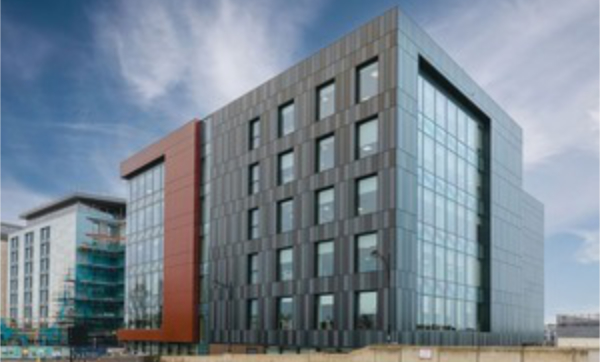Government hub named one of the world’s leading workplaces
The Government Property Agency (GPA) has gained a prestigious world-leading award for its office hub building in Peterborough.
It is the second time the agency has achieved Leesman+ certification – global recognition of exceptional workplace experiences which only six public sector offices worldwide have ever attained.
Quay House, in Peterborough, was opened in March 2023 as the GPA’s first new-build hub within the Government Hubs Programme. It brought together 1,200 civil servants from several government bodies to work in one shared building as part of a £120m regeneration of Fletton Quays.
The building was aligned to the Government Workplace Design Guide across its seven floors, providing flexible, digitally-connected workspaces to support greater productivity, create cost efficiencies and enhance carbon reduction.
The survey results for Quay House showed that 70.1% of respondents agreed ‘It’s a place I’m proud to bring visitors to’, whilst two thirds agreed the building provides an enjoyable environment to work in and enables them to work productively.
Georgina Dunn, Interim Director of Capital Projects, said:
By transforming brownfield sites into industry leading workplaces, our Government Hubs are at the heart of enabling the government’s Places for Growth programme.
For our hubs in Peterborough and Birmingham to be given Leesman+ recognition shows that we are at the forefront of modernising the Civil Service whilst supporting economic growth across the UK, not just in capital cities.
The GPA first achieved Leesman+ certification for its Birmingham hub at 23 Stephenson Street in 2023, which was recognised as the best amongst Leesman+ buildings.
Leesman has surveyed more than 1.35m employees across 9,300 workplaces to establish the world’s largest workplace experience database and benchmark standards across the private and public sectors. Only 269 workplaces have ever achieved its coveted Leesman+ certification.
Louis Roberts, Interim Director of Workplace Services, said:
We recognise the importance of agile and flexible workplace communities that accommodate the diverse needs of civil servants. As these needs continue to evolve, strong insights enable us to adapt our design and delivery models to ensure we are providing workplaces that our customers need, where they feel empowered to work productively.
As well as benchmarking government workplaces against some of the leading offices worldwide, Leesman+ also provides rich insights on behaviours and priorities of building users which informs workplace design and service delivery across the GPA’s portfolio.
Dr Peggie Rothe, Chief Insights and research Officer at Leesman, said:
The addition of the UK Government’s Quay House hub as a Certified Leesman+ workplace presents another powerful illustration that placing employees’ lived workplace experience at the centre of all design and build decisions delivers both outstanding places to work, and great returns on investment.
The GPA’s approach of capturing and analysing a far more granular set of end user factors than nearly any other organisation in Leesman’s fully independent data set, really does enable them to develop more inclusive and supportive workspaces for their Civil Service colleagues.
This article was issued via Press Release as 'Government hub named one of the world’s leading workplaces' dated August 21, 2024.
[edit] Related articles on Designing Buildings
- Appointing consultants.
- Building performance evaluation.
- Building performance metrics.
- Building Use Studies.
- CIBSE Case Study Elizabeth Fry Building.
- Closing the gap between design and as-built performance.
- Energy audit.
- Leesman index.
- Maintenance.
- Performance of exemplar buildings in use: Bridging the performance gap FB 78.
- Performance in use.
- Post occupancy evaluation.
- Post occupancy evaluation process.
- Post-occupancy Review Of Buildings and their Engineering PROBE.
- Sick building syndrome.
- The GPA rated best UK public sector workplace experience.
- Thermal comfort.
- Wellbeing.
- What we know about wellbeing.
Featured articles and news
Latest Build UK Building Safety Regime explainer published
Key elements in one short, now updated document.
UKGBC launch the UK Climate Resilience Roadmap
First guidance of its kind on direct climate impacts for the built environment and how it can adapt.
CLC Health, Safety and Wellbeing Strategy 2025
Launched by the Minister for Industry to look at fatalities on site, improving mental health and other issues.
One of the most impressive Victorian architects. Book review.
Common Assessment Standard now with building safety
New CAS update now includes mandatory building safety questions.
RTPI leader to become new CIOB Chief Executive Officer
Dr Victoria Hills MRTPI, FICE to take over after Caroline Gumble’s departure.
Social and affordable housing, a long term plan for delivery
The “Delivering a Decade of Renewal for Social and Affordable Housing” strategy sets out future path.
A change to adoptive architecture
Effects of global weather warming on architectural detailing, material choice and human interaction.
The proposed publicly owned and backed subsidiary of Homes England, to facilitate new homes.
How big is the problem and what can we do to mitigate the effects?
Overheating guidance and tools for building designers
A number of cool guides to help with the heat.
The UK's Modern Industrial Strategy: A 10 year plan
Previous consultation criticism, current key elements and general support with some persisting reservations.
Building Safety Regulator reforms
New roles, new staff and a new fast track service pave the way for a single construction regulator.
Architectural Technologist CPDs and Communications
CIAT CPD… and how you can do it!
Cooling centres and cool spaces
Managing extreme heat in cities by directing the public to places for heat stress relief and water sources.
Winter gardens: A brief history and warm variations
Extending the season with glass in different forms and terms.
Restoring Great Yarmouth's Winter Gardens
Transforming one of the least sustainable constructions imaginable.























